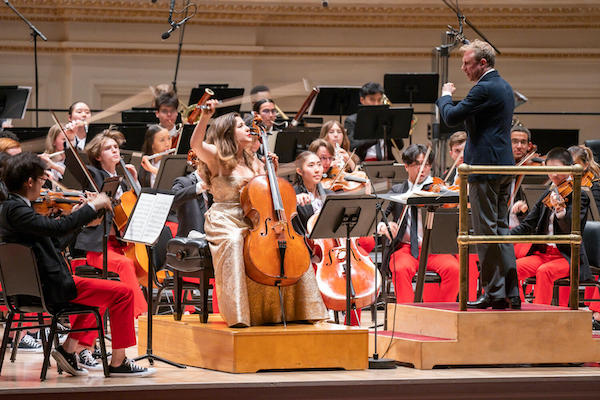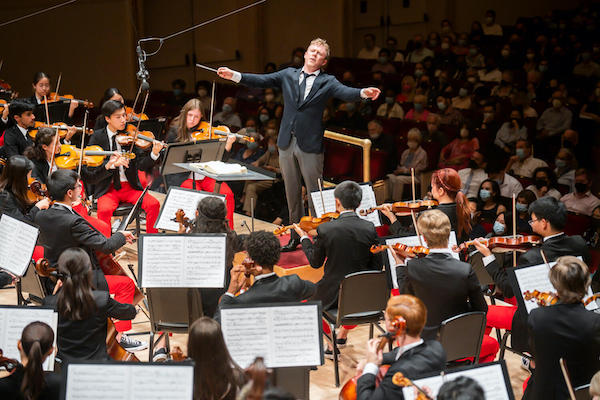National Youth Orchestra of the USA returns with enthusiasm after two-year hiatus

After a two-year pandemic hiatus, one of the most enjoyable classical music events in New York City has returned: the summer Carnegie Hall concert from the National Youth Orchestra of the United States of America.
This orchestra of teenage musicians is now well-established, and this year’s roster—which presented Mahler’s Symphony No. 5 and the Elgar Cello Concerto in Carnegie Friday night—has a good number of players who either have been in previous complements of the ensemble or else came out of NY02, an orchestra for even younger musicians. What does change every year, though, is the conductor and featured soloist, who for 2022 are Daniel Harding and cellist Alisa Weilerstein.
One of the thrills of this group is the inimitable youthful energy, the sensation that they are taking on music they don’t yet know the difficulty of. Because, as has been heard through the years, nothing is beyond these kids. They regularly play with superb individual and ensemble technique and precision, and only lack the kind of complex, subtle sound and approaches to rhythm and articulation that the great professional orchestras take years to develop.
So it was a surprise to hear both some rough ensemble playing and experience several lukewarm stretches Friday night. There were some specific moments, like lip problems in the brass, that one will hear from any orchestra and are simply a part of the live music experience. But there were others that one felt were the results of Harding’s approach and conducting.
The orchestra, and Weilerstein, sounded terrific in the concerto, the ensemble playing with velvety colors and the soloist bringing her typical deep, singing tone and expression. There was great feeling from both, Weilerstein especially was deeply inside the music. The problem was that at times this went too deep, so personal and interior that the expression barely made it off the stage into the audience.
This was a consistent issue whenever the tempo was slow, which in this concerto is often. Harding maintained a steady beat, but the feeling of the music lost momentum and bogged down. It didn’t become heavy or turgid, there was no stumbling, but all the activity seems to be spinning in place, with no direction.
The concerto went back and forth from lovely and enthralling playing to lovely, but distant and objective note-making. It was an odd experience, ultimately so unbalanced that the surging, climactic finale seemed to come out of nowhere, without any buildup of tension nor any connection to what had come before.

This mix of odd interpretive thinking and a lack of attention to detail ran through the Mahler performance. This great symphony is a real challenge for even the best musicians, demanding great technique and energy, and for the most part, these young musicians were up to the task. The string playing was intense and enormously expressive, the woodwinds played with impeccable color, and though the brass section did not have the full presence, snap, and growl that Mahler calls for, the horn section was marvelous in the tremendous scherzo. The musicians played with real relish, seemingly thrilled to be bringing this astonishing symphony to life.
But Harding’s guidance was, again, strangely spotty. In every slow and quiet section, from the first main phrase of the Trauermarsch, the music lacked concentration, intellectual force and body. He took a pause between the Trauermarsch and Stürmisch sections of Part I, which meant he had to take time to rebuild the intensity, and in the Stürmisch and later in the finale, the internal rhythms in the string section lost coordination, and tempo modulations were fraught. There was also an odd lack of portamento, one of the essential Mahlerian touches.
Still, there were excellent things in the interpretation: the climax in the Stürmisch section was as perfect in volume and weight as could be, dynamics were excellent throughout, and the Adagietto was just the right shape and size, flowing but not fast, without indulgence and with great life and feeling from the musicians. The final pages were excellent, and above all there was the sheer excitement and extra-musical beauty and fulfillment of all these kids giving their all to Mahler.
That’s the fundamental and profound pleasure of these concerts, and that was reflected in the encore, Adventures on Earth, John Williams’ suite of his own music from E.T.: The Extraterrestrial. This was extremely polished technically, the sound of the orchestra explosively bright and colorful. And it was also moving to hear these young musicians find so much pleasure in what they were playing.
NYO2 plays music of Jessie Montgomery, Gershwin, and Rachmaninoff with pianist Aaron Diehl and conductor Mei-Ann Chen, 8 p.m. August 1. carnegiehall.org


